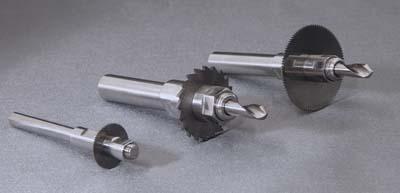
GenSwiss now offers a full range of precision and ultra-precision saw arbors and solid carbide slitting saws. GenSwiss Saw Arbors are furnished in a shank and hub configuration design that provides maximum rigidity and fit, to accommodate the smallest live tool positions such as an ER11 collet. NEW Ultra Precision Combination Arbors provide added flexibility to hold an extra tool such as an end mill, drill, engraving tool or spot tool to suit limited live tool position capacity while achieving added capabilities for maximum productivity.
Made to gage quality standards with a hardened and ground hub mount, GenSwiss Ultra Precision Saw Arbors offer run-out less than .0001" TIR. The nut design applies gripping pressure on the outside edge eliminating any chance of eccentricity from high spots. GenSwiss Saw Arbors are available in both inch and metric sizes. GenSwiss is also able to quote custom arbors.
In addition, the company offers Swiss made solid carbide slitting saws in extra fine tooth configurations with teeth counts ranging from 40-120 teeth per saw also feature superior surface finishes, ground side clearance for increased tool life and maximum performance for cutting hard materials. Special geometries and custom sizes are available upon request.
Contact Details
Related Glossary Terms
- clearance
clearance
Space provided behind a tool’s land or relief to prevent rubbing and subsequent premature deterioration of the tool. See land; relief.
- collet
collet
Flexible-sided device that secures a tool or workpiece. Similar in function to a chuck, but can accommodate only a narrow size range. Typically provides greater gripping force and precision than a chuck. See chuck.
- gang cutting ( milling)
gang cutting ( milling)
Machining with several cutters mounted on a single arbor, generally for simultaneous cutting.
- milling machine ( mill)
milling machine ( mill)
Runs endmills and arbor-mounted milling cutters. Features include a head with a spindle that drives the cutters; a column, knee and table that provide motion in the three Cartesian axes; and a base that supports the components and houses the cutting-fluid pump and reservoir. The work is mounted on the table and fed into the rotating cutter or endmill to accomplish the milling steps; vertical milling machines also feed endmills into the work by means of a spindle-mounted quill. Models range from small manual machines to big bed-type and duplex mills. All take one of three basic forms: vertical, horizontal or convertible horizontal/vertical. Vertical machines may be knee-type (the table is mounted on a knee that can be elevated) or bed-type (the table is securely supported and only moves horizontally). In general, horizontal machines are bigger and more powerful, while vertical machines are lighter but more versatile and easier to set up and operate.
- sawing machine ( saw)
sawing machine ( saw)
Machine designed to use a serrated-tooth blade to cut metal or other material. Comes in a wide variety of styles but takes one of four basic forms: hacksaw (a simple, rugged machine that uses a reciprocating motion to part metal or other material); cold or circular saw (powers a circular blade that cuts structural materials); bandsaw (runs an endless band; the two basic types are cutoff and contour band machines, which cut intricate contours and shapes); and abrasive cutoff saw (similar in appearance to the cold saw, but uses an abrasive disc that rotates at high speeds rather than a blade with serrated teeth).
- shank
shank
Main body of a tool; the portion of a drill or similar end-held tool that fits into a collet, chuck or similar mounting device.
- total indicator runout ( TIR)
total indicator runout ( TIR)
Combined variations of all dimensions of a workpiece, measured with an indicator, determined by rotating the part 360°.
